When choosing the right wholesale water bottles for your business, the material is one of the most important decisions you’ll make. Both stainless steel water bottles and plastic water bottles are popular in the market, but they serve different purposes and appeal to different customer groups. Understanding the advantages and disadvantages of each can help you select the best option for your brand.

Advantages of Stainless Steel Water Bottles
1.Durability & Longevity
Stainless steel bottles are highly durable, resistant to drops, dents, and daily wear. This makes them a long-term choice for customers who want a bottle that can last for years.
2.Temperature Retention
Insulated stainless steel water bottles can keep drinks cold for up to 24 hours and hot for up to 12 hours, making them perfect for travelers, office workers, and outdoor enthusiasts.
3.Premium & Eco-Friendly Image
Many consumers associate stainless steel bottles with quality and sustainability. They are reusable, BPA-free, and help reduce single-use plastic waste, which aligns with eco-conscious buyers.
4.Customization Options
Wholesale stainless steel bottles can be laser-engraved, powder-coated, or custom-printed with your brand logo, giving a high-end look that resonates with corporate clients or premium retail markets.
Disadvantages of Stainless Steel Bottles
•Higher Cost: The manufacturing cost is typically higher than plastic bottles, which may not be suitable for budget-conscious customers.
•Heavier Weight: Stainless steel is heavier, making it less convenient for children or people looking for ultra-light bottles.
Advantages of Plastic Water Bottles
1.Lightweight & Portable
Plastic bottles are much lighter, making them ideal for gyms, schools, and casual use.
2.Affordable Pricing
Plastic water bottles usually come at a lower wholesale cost, making them attractive for promotional events, giveaways, or budget-friendly retail products.
3.Variety in Designs
With advanced molding techniques, plastic bottles can be produced in creative shapes, sizes, and colors. This appeals to younger audiences and promotional markets.
4.Shatter-Resistant
Unlike glass bottles, plastic water bottles won’t break if dropped, which is especially important for kids and outdoor activities.

Disadvantages of Plastic Bottles
•Shorter Lifespan: Plastic bottles may scratch or stain more easily and generally don’t last as long as stainless steel.
•Perception Issues: Even BPA-free plastic bottles may be perceived as less eco-friendly compared to stainless steel.
•Limited Temperature Control: They cannot retain heat or cold effectively.
Which Water Bottle Material Fits Your Brand?
•Targeting Premium or Eco-Friendly Markets → Choose stainless steel water bottles. They highlight sustainability, quality, and long-term value. Perfect for fitness brands, outdoor gear retailers, and corporate gifts.
•Targeting Budget-Friendly or Promotional Markets → Choose plastic water bottles. They’re affordable, colorful, and versatile, making them ideal for giveaways, schools, and mass events.
•Balanced Approach → Many wholesale buyers stock both stainless steel and plastic water bottles, catering to different customer needs.
When deciding between wholesale stainless steel water bottles and wholesale plastic water bottles, consider your target audience, brand positioning, and budget. Stainless steel bottles project a premium and sustainable image, while plastic bottles offer affordability and versatility. The right choice depends on what resonates most with your customers and aligns with your long-term brand strategy.



.jpg?x-oss-process=image/resize,m_pad,h_184,w_260)


 English
English German
German French
French Russian
Russian Spanish
Spanish Japanese
Japanese Korean
Korean Khmer
Khmer Portuguese
Portuguese Ukrainian
Ukrainian Arabic
Arabic
